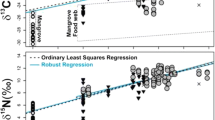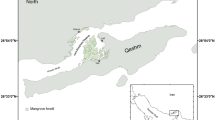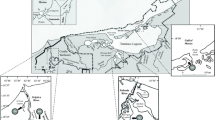Summary
The ratio of stable carbon isotopes (δ13C) in plants and animals from Malaysian mangrove swamps, coastal inlets, and offshore waters was determined. Vascular plants of the swamps were isotopically distinct ( x±s.d.=-27.1±1.2‰) from plankton (-21.0±0.3‰) and other algae (-18.7±2.2‰). Animals from the swamps (-20.9±4.1‰) and inlets (-19.8±2.5‰) had a wide range of isotope ratios (-28.6 to-15.4‰), indicating consumption of both mangrove and algal carbon. Several commercially important species of bivalves, shrimp, crabs, and fish obtained carbon from mangrove trees. Mangrove carbon was carried offshore as detritus and was isotopically distinguishable in suspended particulate matter and sediments. Animals collected from 2 to 18 km offshore, however, showed no isotopic evidence of mangrove carbon assimilation, with ratios (-16.5±1.1‰, range-19.1 to-13.1‰) virtually identical to those reported for similar animals from other plankton-based ecosystems. Within groups of animals, isotope ratios reflected intergencric and interspecific differences in feeding and trophic position. In particular, there was a trend to less negative ratios with increasing trophic level.
Similar content being viewed by others
References
Berry AJ (1972) The natural history of west Malaysian mangrove faunas. Malay Nature J 25:135–162
Black CC, Bender MM (1976) δ13C values of marine organisms from the Great Barrier Reef. Aust J Plant Physiol 3:25–32
Broom MJ (1982) Structure and seasonality in a Malaysian mudflat community. Est Coastal Shelf Sci 15:135–150
Burnett WC, Schaeffer OA (1980) Effect of ocean dumping on 13C/12C ratios in marine sediments from the New York Bight. Est Coastal Mar Sci 11:605–611
Calder JA, Parker PL (1968) Stable carbon isotope ratios as indices of petrochemical pollution of aquatic systems. Environ Sci Technol 2:535–539
Chong VC (1979) The biology of the white prawn Penaeus merguiensis de Man (Crustacea: Penaeidae) in the Pulau Angsa-Klang Strait waters (Straits of Malacca). MS Thesis, Universiti Malaya, Kuala Lumpur, Malaysia
Chong VC, Sasekumar A (1981) Food and feeding habits of the white prawn Penaeus merguiensis. Mar Ecol Prog Ser 5:185–191
Crichton OW (1960) Marsh crab: intertidal tunnel-maker and grasseater. Estuarine Bull 5:3–10
Dall W (1968) Food and feeding of some Australian penaeid shrimp. In: Proceedings of the World Scientific Conference on the Biology and Culture of Shrimps and Prawns, FAO Fisheries Report 2, Rome, pp 251–258
DeNiro M, Epstein S (1978) Influence of diet on the distribution of carbon isotopes in animals. Geochim Cosmochim Acta 42:495–506
Doner LW, Bills DD (1982) Mass spectrometric 13C/12C determinations to detect high fructose corn syrup in orange juice: collaborative study. J Assoc Off Anal Chem 65:608–610
Doner LW, Phillips JG (1981) Detection of high fructose corn syrup in apple juice by mass spectrometric 13C/12C analysis: collaborative study. J Assoc Off Anal Chem 64:85–90
Eadie BJ, Jeffrey LM (1973) δ13C analysis of oceanic particulate organic matter. Mar Chem 1:199–209
Fry B (1977) Stable carbon isotope ratios — a tool for tracing food chains. MS Thesis, University of Texas, Austin
Fry B (1981) Natural stable isotope tag traces Texas shrimp migrations. Fish Bull 79:337–345
Fry B, Arnold C (1982) Rapid 13C/12C turnover during growth of brown shrimp (Penaeus aztecus). Oecologia (Berlin) 54:200–204
Fry B, Joern A, Parker PL (1978) Grasshopper food web analysis: use of carbon isotope ratios to examine relationships among terrestrial herbivores. Ecol 59:498–506
Fry B, Parker PL (1979) Animal diet in Texas seagrass meadows: δ13C evidence for the importance of benthic plants. Est Coastal Mar Sci 8:499–509
George MJ (1970) Synopsis of biological data on the penaeid prawn Metapenaeus brevicornis (H. Milne Edwards, 1837). In: Proceedings of the World Scientific Conference on the Biology and Culture of Shrimps and Prawns, FAO Fisheries Report 57, Mistakidis MN (ed), Rome, pp 1559–1573
Golley F, Odum HT, Wilson RF (1962) The structure and metabolism of a Puerto Rican red mangrove forest in May. Ecol 43:9–19
Guy RD, Reid DM, Krouse HR (1980) Shifts in carbon isotope ratios of two C3 halophytes under natural and artificial conditions. Oecologia (Berlin) 44:241–247
Hackney C, Haines EB (1980) Stable carbon isotope composition of fauna and organic matter collected in a Mississippi estuary. Est Coastal Mar Sci 10:703–708
Haines EB (1976a) Stable carbon isotopes in the biota, soils and tidal waters of a Georgia salt marsh. Est Coastal Mar Sci 4:609–616
Haines EB (1976b) Relation between the stable carbon isotope composition of fiddler crabs, plants and soils in a salt marsh. Limnol Oceanogr 21:880–883
Haines EB, Montague CL (1979) Food sources of estuarine invertebrates analyzed using 13C/12C ratios. Ecol 60:48–56
Ikematsu W (1955) On the life history of Metapenaeus joyneri (Miers) in an Ariake Sea. Bull Jap Soc Sci Fish 20:969–978
Kuenzler EJ (1974) Mangrove swamp systems. In: Coastal Ecological Systems of the United States, Odum HT, Copeland BJ, McMahan EA (eds), Washington, pp 346–371
Leh CMU, Sasekumar A (In press) Feeding ecology of prawns in shallow waters adjoining mangrove shores. In: Proceedings of the Asian Symposium on Mangrove Environment: Research and Management, Soepadmo E (ed) New York
Lowdon JA, Dyck W (1974) Seasonal variations in the isotope ratios of carbon in maple leaves and other plants. Can J Earth Sci 11:79–88
McConnaughey T, McRoy CP (1979a) Food web structure and the fractionation of carbon isotopes in the Bering Sea. Mar Biol 53:257–262
McConnaughey T, McRoy CP (1979b) 13C label identifics eelgrass (Zostera marina) carbon in an Alaskan estuarine food web. Mar Biol 53:263–269
McMillan C, Parker PL, Fry B (1980) 13C/12C ratios in seagrasses. Aquat Bot 9:237–249
Macko SA (1981) Stable nitrogen isotope ratios as tracers of organic geochemical processes. Ph D Dissertation, University of Texas, Austin
Macko SA, Lee WY, Parker PL (1982) Nitrogen and carbon isotope fractionation by two species of marine amphipods: lab and field studies. J Exp Mar Biol Ecol 63:145–149
MacNae W (1968) A general account of the fauna and flora of mangrove swamps and forests in the Indo-West Pacific region. Adv Mar Biol 6:73–270
MacNae W, Kalk M (1962) The ecology of the mangrove swamps at Inhaca Island, Mozambique. J Ecol 50:19–34
Mann K (1972) Macrophyte production and detritus food chains in coastal waters. In: Proceedings of the IBP-UNESCO Symposium on Detritus and Its Ecological Role in Aquatic Ecosystems, Melchiorri-Santolini U, Hopton JW (eds), Rome: Mem Ist Ital Idrobiol, pp 353–383
Mathias J (1978) The possible significance of leaf fall and decomposition in Malaysian mangrove swamps. Malay Nature J 30:433–444
Miller DC (1961) The feeding mechanisms of fiddler crabs with ecological considerations of feeding adaptations. Zool 46:89–100
Mohamed KH (1970) Synopsis of biological data on the Indian prawn Penaeus indicus (H. Milne Edwards, 1837). In: Proceedings of the World Scientific Conference on the Biology and Culture of Shrimps and Prawns, FAO Fisheries Report 57, Mistakidis MN (ed), Rome, pp 1267–1288
Morton B (1976) The biology and functional morphology of the S.E. Asian mangrove bivalve Polymesoda (Geloina) erosa (Solander, 1786) (Bivalvia: Corbiculidae). Can J Zool 54:482–500
Odum WE, Heald E (1975) The detritus based food chain of an estuarine mangrove community. In: Estuarine Research Vol. I, Cronin LE (ed), Academic Press, New York, pp 265–286
Ono Y (1965) On the ecological distribution of ocypodid crabs in the estuary. Mem Fac Sci Kyushu Univ Ser E 4:1–60
Parker PL (1964) The biogeochemistry of the stable carbon isotopes in a marine bay. Geochim Cosmochim Acta 28:1155–1164
Parker PL, Behrens EW, Calder JA, Shultz D (1972) Stable carbon isotope ratio variations in the organic carbon from the Gulf of Mexico. Contrib Mar Sci, Univ Texas 16:139–147
Petelle M, Haines B, Haines E (1979) Insect food preferences analyzed using 13C/12C ratios. Oecologia (Berlin) 38:159–166
Peterson BJ, Howarth RW, Lipshultz F, Ashendorf D (1980) Salt marsh detritus: an alternative interpretation of stable carbon isotope ratios and the fate of Spartina alterniflora. Oikos 34:173–177
Sanders HL (1960) Benthic studies in Buzzards Bay IV. The structure of the soft-bottom community. Limnol Oceanogr 5:138–153
Sasekumar A (1974) Distribution of macrofauna on a Malayan mangrove shore. J Animal Ecol 43:51–69
Sastrakusumah S (1971) A study of the food of juvenile migrating pink shrimp Penaeus duorarum Burkenroad. Sea Grant Bull 9, University of Miami, Miami
Sirevag R, Buchanan BB, Berry JA, Troughton JH (1977) Mechanism of CO2 fixation in bacterial photosynthesis studied by the carbon isotope fractionation technique. Arch Microbiol 112:35–38
Smith B, Epstein S (1971) Two categories of 13C/12C for higher plants. Plant Physiol 47:380–384
Steneck RS, Watling L (1982) Feeding capabilities and limitation of herbivorous molluscs: a functional group approach. Mar Biol 68:299–319
Teeri JA, Schoeller DA (1979) δ13C values of an herbivore and the ratio of C3 to C4 plant carbon in its diet. Oecologia (Berlin) 39:197–200
Thayer GW, Parker PL, LaCroix MW, Fry B (1978) The stable carbon isotope ratio of some components of an eelgrass, Zostera marina, bed. Oecologia (Berlin) 35:1–18
Tieszen LL, Boutton TW, Tesdahl KG, Slade NA (1983) Fractionation and turnover of stable carbon isotopes in animal tissues: implications for δ13C analysis of diet. Oecologia (Berlin) 57:32–37
Wiebe WJ, Pomeroy LR (1972) Micro-organisms and their associations with aggregates and detritus in the sea: a microscopic study. In: Proceedings of the IBP-UNESCO Symposium on Detritus and Its Ecological Role in Aquatic Ecosystems, melchiorri-Santolini U, Hopton JW (eds), Rome, Mem Ist Ital Idrobiol, pp 325–352
Williams AB (1955) A contribution to the life history of commercial shrimp (Penaeidae) in North Carolina. Bull Mar Sci 5:116–146
Author information
Authors and Affiliations
Rights and permissions
About this article
Cite this article
Rodelli, M.R., Gearing, J.N., Gearing, P.J. et al. Stable isotope ratio as a tracer of mangrove carbon in Malaysian ecosystems. Oecologia 61, 326–333 (1984). https://doi.org/10.1007/BF00379629
Received:
Issue Date:
DOI: https://doi.org/10.1007/BF00379629




